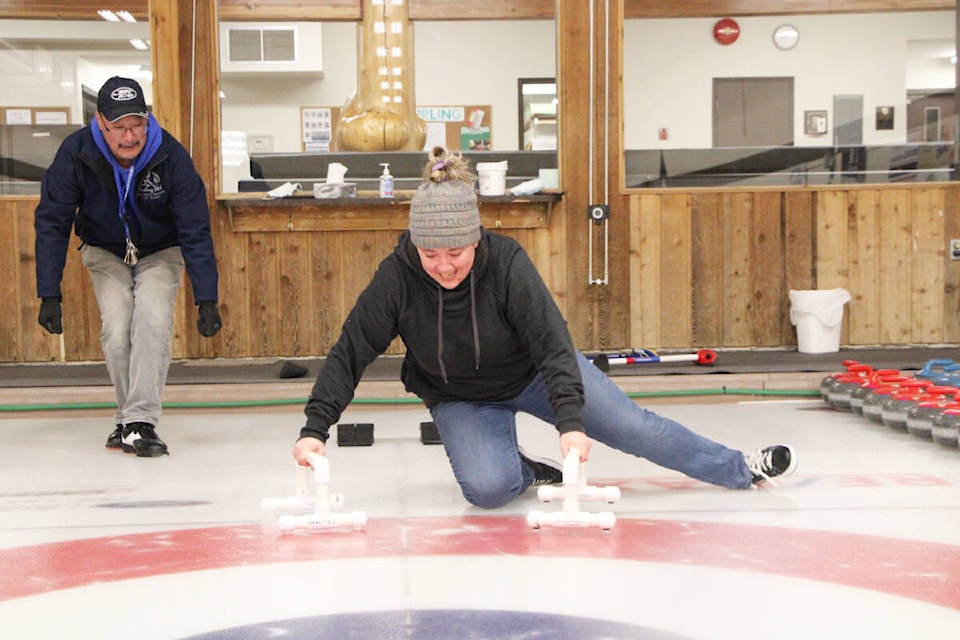“This is a lot harder than it looks!”
It’s a phrase 100 Mile Curling Club instructor Richard Minato hears often, and I was no exception last week when I took part in my first attempt at curling.
The opportunity to learn the basics of the sport - thanks to the club’s free learn-to-curl lessons this month - was an eye-opening experience. Before last week, my only knowledge of curling came from TV, where the competitors make their graceful glides down the rink look so effortless.
As I quickly learned, there is a tremendous amount of technique, balance, muscle memory and strategy to the game.
Minato’s first piece of advice - which would prove to be invaluable - was to be sure to stretch before stepping onto the sheet.
“You’re going to be using muscles that you’ve never used before,” he said as we balanced on one leg, stretching our hamstrings.
The next few minutes were spent getting accustomed to maneuvering on the ice, which in itself is tricky, while wearing one grip shoe and one slider shoe.
Before diving right into gliding rocks down the rink, Minato showed me the meticulous step-by-step process to do so, using plastic crutches for balance, and in place of rock and broom.
Crouching down with my grip foot propped on the hack, I lifted my hips, pulled my slider foot back slightly then pushed off - and, promptly fell over.
After a few more failed attempts, I was able to slowly glide forward, balanced on my slide foot while my back foot gently dragged behind me. The key to a successful glide, Minato said, is keeping your body as low to the ground as possible, with your slide foot slightly turned out but centred directly under your body.
Admittedly, it is a lot to remember in the span of just a few seconds, especially when you’re focused on keeping your balance and not spilling ungainly onto the ice.
It became apparent that the more forward momentum you have, the easier it is to keep your balance and with each attempt, I glided a little further down the ice.
“It takes a lot of practice,” Minato assured me. “I usually ask people after their first or second lesson, to go home and put on a wool slipper and practice on their linoleum floor.”
After seven or eight attempts, my thigh muscles were protesting so Minato showed me an alternative way to deliver the rock, by using a stick.
This is a preferred method for anyone with balance or mobility issues, he noted, as he demonstrated the shuffleboard-like technique of briskly walking down the ice with a stick affixed to the rock, before releasing it with a strong push.
It was definitely a simpler method but still required focus, technique and a fair amount of strength and balance.
As Minato explained the rules of the game and the role of each of the four players - lead, second, third and skip - we practiced a few techniques for sweeping, which he explained makes the rock go further and not curl as much, based on the skip’s orders.
“The skip determines the strategy, they’re probably the most knowledgable on the team,” he said. “They have the challenge of reading the ice and knowing how much the rock is going to curl.”
After a brief rest for my legs, I was back on the ice, this time attempting to deliver a rock. A few more stumbles and spills later, I managed to glide a rock past the minimum distance required for it to be in fair play. Success!
The 100 Mile Curling Club is currently hosting its free Learn to Curl program Monday nights throughout the month of February. No previous experience or equipment is required, other than clean shoes, warm, flexible clothing and gloves.
COVID-19 protocols are in place and anyone interested can pre-register by calling Grant at 250-791-1951.
Minato said the timing of the introductory program is perfect, as professional curlers from around the world prepare to take centre stage at the Beijing Winter Olympics.
“There is curling all over TV right now, so it might pique some interest.”
melissa.smalley@100milefreepress.net
Like us on Facebook and follow us on Twitter
